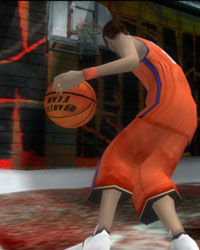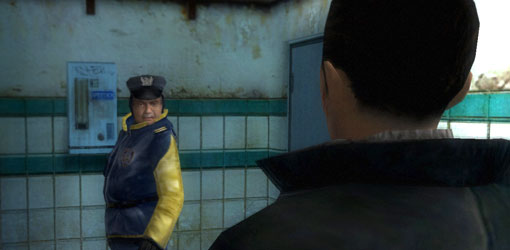INDIGO PROPHECY: Developer's Diary

THE STORY
The Scenario
It is always difficult to know exactly where inspiration comes from where you write a story. I remember that the first idea for Indigo Prophecy came while watching Brian De Palma's Snake Eye. The story was about a murder seen from different perspectives through the flashbacks of the different characters. I felt that this idea was a great gameplay mechanic and I started working on the idea of a murder in a public place. Most of my influences came almost exclusively from movies. I felt that a lot of things that were seen as "established" should be reconsidered for Indigo Prophecy. Mechanics, ramping, interface, all these things had to be different in order to create the kind of experience I had in mind.
I remember pitching my game to a journalist and hearing his response, "storytelling? That's not fun!" My answer was simple, "define fun." Our discussion fell short... The usual definition of the "fun factor" takes us back to the notion of "killing and destruction," but I had nothing like that in my concept... I knew I would have to face this kind of resistance and prove that fun can be created in different ways.
 Back to my influences, I was inspired by movies like David Fincher's Seven for the way the intimate backgrounds of the characters are closely linked to the main story, Fight Club for the way voice over work was used, as well as David Lynch's Dune. Voice over work helped a lot in Indigo Prophecy, both as a useful narrative device and as a strong gameplay component. Adrian Lyne's Jacob's Ladder (a true masterpiece) inspired me when it came to the deformed reality attacking Lucas, and Alan Parker's Angel Heart was a great source for tackling a character with no other choice than to face his destiny.
Back to my influences, I was inspired by movies like David Fincher's Seven for the way the intimate backgrounds of the characters are closely linked to the main story, Fight Club for the way voice over work was used, as well as David Lynch's Dune. Voice over work helped a lot in Indigo Prophecy, both as a useful narrative device and as a strong gameplay component. Adrian Lyne's Jacob's Ladder (a true masterpiece) inspired me when it came to the deformed reality attacking Lucas, and Alan Parker's Angel Heart was a great source for tackling a character with no other choice than to face his destiny.The idea that we don't really have any true choice in our daily lives was a very interesting concept for me, especially when presented in a media based solely on choices. In our lives we believe that we are free, but we usually only do what is expected from us. We can do virtually anything, but we just do what sounds reasonable. The allegory was perfect with the narrative experience I was trying to create. I wanted to make the player believe that he is entirely free, but of course, he just does what I was expecting him to do. The hero himself states that very clearly in the opening sequence by saying that he is "just a pawn living his pawn's life." Of course, this is a little bit esoteric and very few people will pay attention, but I guess it gives a special flavor to the whole experience.
Episodic Content
Initially, Indigo Prophecy was supposed to be sold as an episodic game. I started working on the plot and the first episodes based on the TV series format, with an ongoing story, recurring characters and cliffhangers at the end of each of the 12 episodes. I wrote a full bible for the world and all of the characters with the idea to create a reference in order to share the writing between several writers. I also developed a significant number of side stories that would run in parallel, generally related to the lives of the main characters.
This is how I came with the more intimate scenes in the game; Carla at her apartment, Tyler dealing with his private issues with his girlfriend, Lucas with his ex-girlfriend, etc. I wrote all of these scenes where we see the main characters at home in their private lives dealing with their personal affairs in order to generate some side stories that I could develop throughout the episodes. When the format was abandoned, I did not have the heart to cut them entirely, so I left bits in here and there. Without this history, I guess I would have never thought about writing these scenes this way. I really think that they significantly contribute to make Indigo Prophecy the experience it is today.

Characters
Splitting the focus of the game between the main characters was an important task. Because the game was based on the idea of switching between different characters, all of them had to present some kind of focal point, although it was obvious from the start that there would be only two real heroes to the story, Lucas and Carla. Their roles were defined quite early in the process. Lucas would be the cursed hero, accused of a murder he did not really commit, and the victim of visions trying to kill him while he searches for the truth, while Carla would be the professional, cold investigator, only believing in reality. He would be on the supernatural side; she would be on the reality. Although one is the murderer and the other the cop, they both have the same goal; namely to discover what happened the night of the murder.
The player alternates between the different characters, collecting clues from both sides, and being the only one to get the full picture. As we see in Hitchcock movies, the audience always knows more than the characters.
Tyler Miles, Carla's teammate, was an interesting character for us to develop. I tried to characterize him as much as possible, by making him a kind of Shaft-style character, stuck in the 70's. He is also the only character with any funny scenes in a story that is generally quite dark.
I decided at the beginning of the project that the opening sequence would have to be very striking. I wanted the player to be immediately thrown into the story and have him empathize with the main character. Making Lucas a murderer was a difficult decision to make. I was convinced that the player would empathize with a character accused of a murder he did not really commit though. He would easily identify with Lucas and would share his fear. Many people, especially from marketing, feared that the player would be reluctant to help someone he did actually see killing someone. They were wrong. When we started testing the game, we quickly realized that people liked the idea of being a murderer not responsible for his actions.
From a narrative perspective, the guilt felt by Lucas was extremely interesting. Are we responsible for what we do even if its something we have no control over? Giving Lucas a brother who is also a priest was a convenient way to expose his struggle. Markus represents the law and morality, while Lucas is about ambiguity and fatalism. I guess this contrast reinforces the empathy the player feels for his character.
NEXT >>
Labels: David Cage, Developers Diaries, English, Fahrenheit Indigo Prophecy
Previous News
- INDIGO PROPHECY: Developer's Diary
- INDIGO PROPHECY: Developer's Diary
- INDIGO PROPHECY: Developer's Diary
- Quantic Dream choose Malaysia
- GamePro.com: Q & A with David Cage About Indigo Pr...
- Fahrenheit Poland
- JeuxVideo: David Cage est ici
- Fahrenheit ( Пророчество цвета Индиго) Russian
- Fahrenheit Australia and NZ
- Fahrenheit (Indigo Prophecy) Swerige


 Thursday, September 22, 2005
Thursday, September 22, 2005